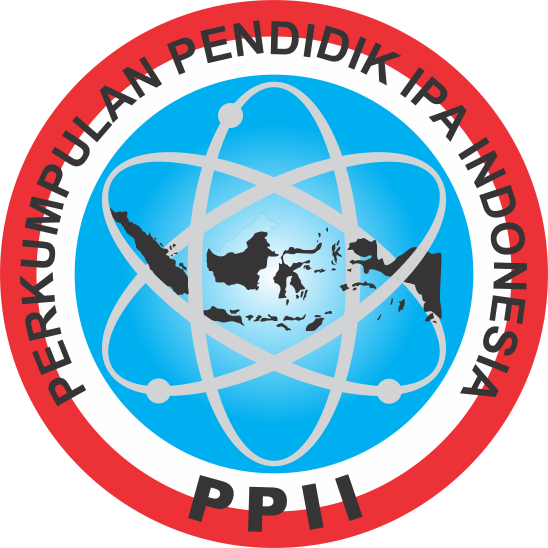BLENDED LEARNING DENGAN PENDEKATAN STEM SEBAGAI INOVASI PEMBELAJARAN ABAD 21
Abstract
Keywords
Full Text:
PDFReferences
Ardianti, S., Sulisworo, D., & Pramudya, Y. (2019). Efektivitas Blended Learning Berbasis Pendekatan Stem Education Berbantuan Schoology Untuk Meningkatkan Critical Thinking Skill Pada Materi Fluida Dinamik. Prosiding Seminar Nasional Pendidikan KALUNI, 2(February). https://doi.org/10.30998/prokaluni.v2i0.67
Ardianti, S., Yahya, F., & Fitrianto, S. (2020). The Impact of Using the STEM Education Approach with Blended Learning to Increase Students’ Learning Interest Suji. Indonesian Journal of STEM Education, 2(1), 1–10. http://dx.doi.org/10.1016/j.ndteint.2014.07.001%0Ahttps://doi.org/10.1016/j.ndteint.2017.12.003%0Ahttp://dx.doi.org/10.1016/j.matdes.2017.02.024
Banila, L., Lestari, H., & Siskandar, R. (2021). Penerapan blended learning dengan pendekatan STEM untuk meningkatkan kemampuan literasi sains siswa pada pembelajaran biologi di masa pandemi covid-19. Journal of Biology Learning, 3(1), 25. https://doi.org/10.32585/jbl.v3i1.1348
Bazelais, P., & Doleck, T. (2018). Investigating the impact of blended learning on academic performance in a first semester college physics course. Journal of Computers in Education, 5(1), 67–94. https://doi.org/10.1007/s40692-018-0099-8
Bybee, R. W. (2010). What is STEM education? Science, 329(5995), 996. https://doi.org/10.1126/science.1194998
Cahyono, E. A., Sutomo, & Harsono, A. (2019). Literatur Review: Panduan Penulisan dan Penyusunan. Jurnal Keperawatan, 12.
Dugger, W. E. (2010). Evolution of STEM in the United States. 6Th Biennial International Conference on Technology Education Research, March, 1–8. http://www.iteea.org/Resources/PressRoom/AustraliaPaper.pdf
Febrianto, T., Ngabekti, S., & Saptono, S. (2021). The Effectiveness of Schoology-Assisted PBL-STEM to Improve Critical Thinking Ability of Junior High School Students. Journal of Innovative Science Education, 10(908), 222–229. https://journal.unnes.ac.id/sju/index.php/jise/article/view/42993
Gestira, M., Abdurrahman, & Viyanti. (2021). PjBL-Based Blended Learning Implementation on Energy Topic to Improve the Problem-Solving Skill. Impulse: Journal of Research and Innovation in Physics Education, 1(1), 32–41. https://doi.org/10.14421/impulse.2021.11-04
Hernández, Y., Pérez-Ramírez, M., Zatarain-Cabada, R., Barrón-Estrada, L., & Alor-Hernández, G. (2016). Designing empathetic animated agents for a B-learning training environment within the electrical domain. Educational Technology and Society, 19(2), 116–131.
Insani, S. N., Purwanto, A., Risdianto, E., Supratman, J. W. R., Limun, K., Muara, K., & Hulu, B. (2021). Jurnal Pendidikan Fisika COVID-19 PANDEMIC. 10, 104–111.
Kadir, A. R., & Keguruan, F. T. (2014). Laboratorium Riil Dengan Laboratorium Virtual.
Kelley, T. R., & Knowles, J. G. (2016). A conceptual framework for integrated STEM education. International Journal of STEM Education, 3(1). https://doi.org/10.1186/s40594-016-0046-z
Khader, N. S. K. (2016). The Effectiveness of Blended Learning in Improving Students’ Achievement in Third Grade’s Science in Bani Kenana. Journal of Education and Practice, 7(35), 109–116. http://libproxy.library.wmich.edu/login?url=https://search.proquest.com/docview/1895979064?accountid=15099
Lestari, H., Rahmawati, I., Siskandar, R., & Dafenta, H. (2021). Implementation of Blended Learning with A STEM Approach to Improve Student Scientific Literacy Skills During The Covid-19 Pandemic. Jurnal Penelitian Pendidikan IPA, 7(2), 224. https://doi.org/10.29303/jppipa.v7i2.654
Listiana, N., & Jaharadak, A. A. (2019). Blended Learning as Instructional Media: Literature Review. Journal of Physics: Conference Series, 1167(1). https://doi.org/10.1088/1742-6596/1167/1/012066
Maskur, Anwar, M. K., & Trianah. (2021). Implementasi Pembelajaran Blended Learning Di Madrasah Ibtidaiyah. Jurnal Magistra, 12(2). https://doi.org/10.31942/mgs
Nasution, N., Jalinus, N., & Syahril. (2019). Buku Modul Blended Learning. Unilak Press.
Ngabekti, S., Partaya, HB, P. M., & Nugroho, B. (2019). Students’ literacy profile on STEM-blended learning implementation in ecosystem material. IOP Conference Series: Materials Science and Engineering.
Nisrina, N., Jufri, A. W., & Gunawan, G. (2020). Pengembangan LKPD Berbasis Blended Learning untuk Meningkatkan Literasi Sains Peserta Didik. Jurnal Pijar Mipa, 15(3), 192–199. https://doi.org/10.29303/jpm.v15i3.1880
NSF. (2020). STEM Education For The Future. 1(2018), 75–86.
Oversby, J., Sanders, J., Talib, C. A., Thoe, N. K., & Esa, N. (2019). Question Generating Supported by Blended Learning Platform: Issues of Social Justice for Environmental Education. Eurasia Journal of Mathematics, Science and Technology Education, 15(5).
Piper, R. J. (2013). How to write a systematic literature review: a guide for medical students. National AMR, 1(2), 1–8. http://cures.cardiff.ac.uk/files/2014/10/NSAMR-Systematic-Review.pdf%0Acures.cardiff.ac.uk/files/2014/.../NSAMR-Systematic-Review.pdf
Prisecaru, P. (2019). Global challenges of the fourth industrial revolution. Terra Economicus, 17(2), 6–22. https://doi.org/10.23683/2073-6606-2019-17-2-6-22
Puspitarini, D. (2022). Blended Learning sebagai Model Pembelajaran Abad 21. Ideguru: Jurnal Karya Ilmiah Guru, 7(1), 1–6. https://doi.org/10.51169/ideguru.v7i1.307
Rahmat, N., & Suparman. (2018). Deskripsi Kebutuhan Media Pembelajaran E-Learning Berpendekatan STEM Untuk Mengembangkan Kemampuan Berpikir Kritis dan Kreatif Siswa SMA Kelas XI. Seminar Nasional Pendidikan …, 194–199. http://seminar.uad.ac.id/index.php/sendikmad/article/view/994
Ridwan, M., Ulum, B., Muhammad, F., Indragiri, I., & Sulthan Thaha Saifuddin Jambi, U. (2021). Pentingnya Penerapan Literature Review pada Penelitian Ilmiah (The Importance Of Application Of Literature Review In Scientific Research). Jurnal Masohi, 2(1), 42–51. http://journal.fdi.or.id/index.php/jmas/article/view/356
Riyana, C. (2019). Tantangan Pendidikan Era Revolusi Industri 4.0. April, 0–9. http://berita.baca.co.id//26834470
Sanders, M. (2009). STEM, STEM Education, STEMmania. The Technology Teacher, 68(4), 20–26. https://doi.org/10.11340/skinresearch1959.41.49
Sartika, S. B., Efendi, N., & Wulandari, F. E. (2022). Relationship of Students’ Activities, Responses, and Cognitive Learning Outcomes on Natural Science Learning-Based Ethno-STEM in Secondary School. Prisma Sains : Jurnal Pengkajian Ilmu Dan Pembelajaran Matematika Dan IPA IKIP Mataram, 10(1), 84. https://doi.org/10.33394/j-ps.v10i1.4655
Setyaningsih, E., Adnan, M., Ahmad, C. N. C., & Anif, S. (2021). Literature Review: Development of STEM Learning in Indonesia Based on Variation of Subjects, Media, and Strategy of Study from 2015 to 2019. Eview of International Geographical Education Online, 11(4), 1023–1033.
Shahroom, A. A., & Hussin, N. (2018). Industrial Revolution 4.0 and Education. International Journal of Academic Research in Business and Social Sciences, 8(9), 314–319. https://doi.org/10.6007/ijarbss/v8-i9/4593
Supriyati, Y., Permana, A. H., & Aziz, N. D. S. (2020). Bahan Ajar Elektronik Berbasis Stem Untuk Blended Learning Pada Materi Fluida Sma. IX, 105–114. https://doi.org/10.21009/03.snf2020.02.pf.16
Wright, G. A., Hurd, R. C., Hacking, K. S., & Truscott, T. (2014). Using ROVs to teach a blended STEM curriculum. ASEE Annual Conference and Exposition, Conference Proceedings. https://doi.org/10.18260/1-2--23275
Yahya, M. S., & Hashim, H. (2021). Interdisciplinary Learning and Multiple Learning Approaches in Enhancing the Learning of ESL among STEM Learners. In Creative Education (Vol. 12, Issue 05, pp. 1057–1065). https://doi.org/10.4236/ce.2021.125078
Zulirfan, Z., Yennita, Y., Rahmad, M., & Purnama, A. (2021). Desain dan Konstruksi Prototype KIT Proyek STEM Sebagai Media Pembelajaran IPA SMP Secara Daring pada Topik Aplikasi Listrik Dinamis. Journal of Natural Science and Integration, 4(1), 40. https://doi.org/10.24014/jnsi.v4i1.11446
Refbacks
- There are currently no refbacks.


